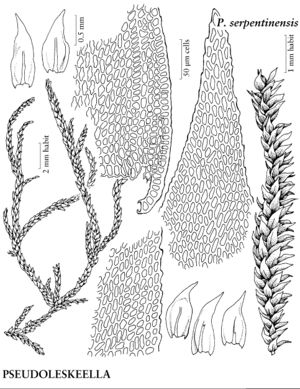Pseudoleskeella
Eur. N. Amer. Bryin., 47. 1897.
| Taxon | Illustrator ⠉ | |
|---|---|---|
 | Pseudoleskeella serpentinensis | Patricia M. Eckel |
 | Pseudoleskeella tectorum | Patricia M. Eckel |
Plants small, in thin mats or patches, yellow to red-green, redbrown, green, or olive green. Stems irregularly branched, branches appressed to ascending or erect, not clustered; paraphyllia absent; rhizoids in clusters arising from base of leaves. Stem and branch leaves differentiated. Stem-leaves catenulate or not, appressed to erect when dry, erect-spreading when moist, ovate to lanceolate, not to sometimes 2-plicate; margins plane or recurved, entire to serrulate distally; apex abruptly to gradually acuminate, hairpoint absent; costa single, double, 2-fid, or rarely ecostate, strong to weak, short to percurrent, not sinuate, sometimes somewhat obscure distally; alar cells not well differentiated, quadrate to short-rectangular; proximal laminal cells 1–2: 1, walls not or obscurely pitted; medial cells isodiametric, 2–3: 1, smooth, walls firm to incrassate. Branch leaves more ovate, smaller; apex often especially recurved or falcate; costa usually weaker; medial laminal cells usually shorter. Specialized asexual reproduction absent. Sexual condition dioicous; perichaetial leaves pale translucent, appressed to rarely recurved, longer, apex more acuminate. Seta 0.1–0.3 cm. Capsule erect or inclined, subcylindric to cylindric, curved-asymmetric or sometimes symmetric; annulus present; operculum conic, short-rostrate; peristome well developed; exostome teeth lanceolate or linear-lanceolate, finely horizontally striate; endostome basal membrane moderately high, segments slender, lanceolate to filiform, cilia present, usually well developed. Spores 8–18 µm, finely papillose.
Distribution
North America, Mexico, Eurasia
Discussion
Species 6 (4 in the flora).
Pseudoleskeella is found mostly in cool-temperate, montane, arctic-alpine, and boreal-temperate regions; the plants are small, slender, and appressed, with many branches, smooth laminal cells, no paraphyllia, straight to flexuose setae, and a relatively weak costa, often 2-fid. The older stoloniferous leaves are distant, often denuded, scalelike, and sometimes hyaline; occasionally some distal laminal cells become weakly prorate. However, the species seem to be quite different from each other morphologically beyond these few shared traits. Molecular studies have shown that P. serpentinensis is not related to the other species; rather it appears to be closest to Heterocladium (Pterigynandraceae) (M. S. Ignatov et al. 2007). Following P. S. Wilson and D. H. Norris (1989), P. catenulata (Bridel ex Schrader) Kindberg and P. papillosa (Lindberg) Kindberg are excluded from North America.
Selected References
None.
Lower Taxa
Key
| 1 | Stem leaves ± catenulate when dry; costae usually double, not reaching mid leaf; stems tightly appressed to substrate. | Pseudoleskeella tectorum |
| 1 | Stem leaves not catenulate when dry; costae usually single, rarely 2-fid, usually to mid leaf or sometimes percurrent; stems not tightly appressed to substrate | > 2 |
| 2 | Plants green to yellow-green; leaves distinctly plicate; bases flaring, cordate; margins recurved to mid leaf or beyond, distinctly serrulate distally. | Pseudoleskeella arizonae |
| 2 | Plants green to red; leaves not or weakly plicate; bases not flaring or cordate; margins plane throughout or recurved proximally, ± entire or finely serrulate distally | > 3 |
| 3 | Stem leaves broadly lanceolate to ovate-lanceolate, not homomallous, gradually narrowed to apex; apices not falcate; costae usually beyond mid leaf, rarely 2-fid; plants green, red-green, or orange-green; branch leaf laminal cell walls thin. | Pseudoleskeella rupestris |
| 3 | Stem leaves ovate to lanceolate, homomallous, abruptly narrowed to apex; apices sometimes falcate; costae short and 2-fid to single and reaching mid leaf or sometimes beyond; plants red, red-brown, or green; branch leaf laminal cell walls incrassate. | Pseudoleskeella serpentinensis |
"broad" is not a number.